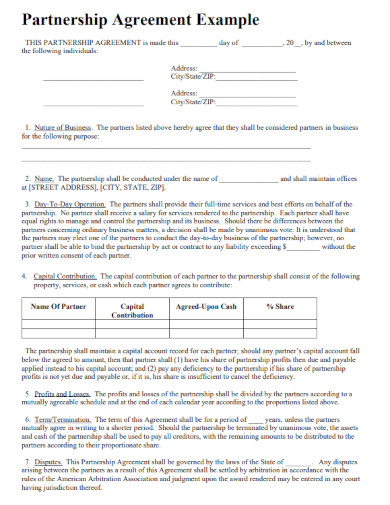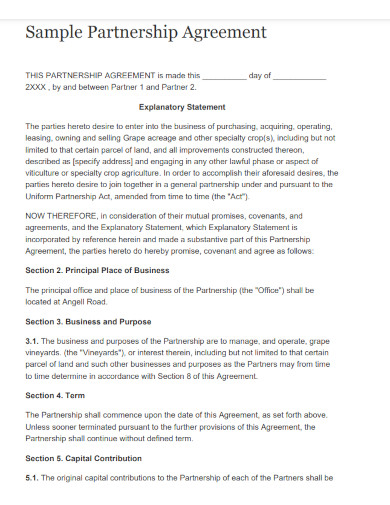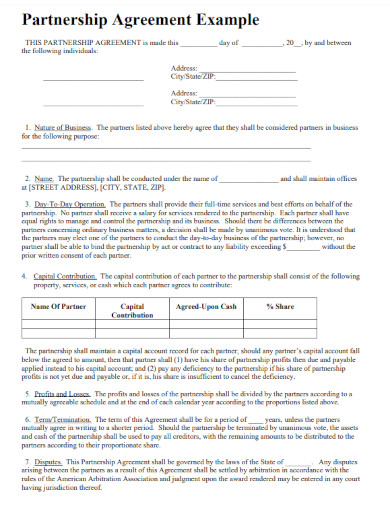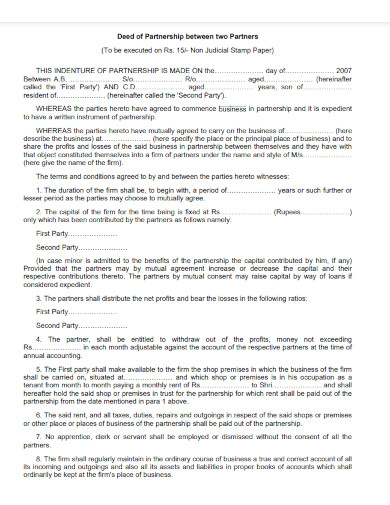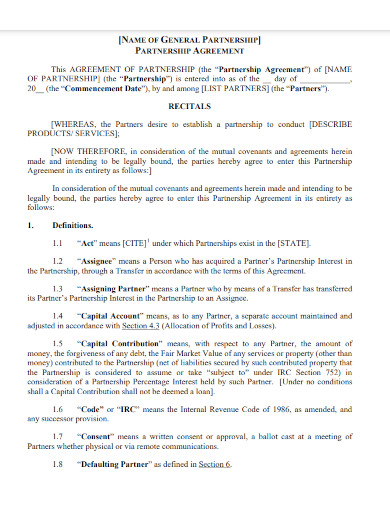Establishing partnerships within the business community or industry to ensure the growth and development of businesses or companies of any type or size. Entrepreneurs utilize strategic planning in building partnerships and operating their businesses which is still used today. There are various types of partnerships which range from a business owner participating in investing in a project to sharing knowledge and ideas between companies and businesses. A small business agreement records the benefits a company and its partner will receive and sign by the parties involved.
5+ Small Business Partnership Agreement Samples
1. Small Business Partnership Agreement Template
2. Small Business Partnership Agreement Statement
3. Small Business Framework Partnership Agreement
4. Small Business Deed Of Partnership Between Two Partners
5. Small Business Channel Partnership Agreement
6. Small General Business Partnership Agreement
What is a Small Business Partnership Agreement Template?
A small business partnership agreement template is a legally binding document that establishes and outlines the operation rules of a business and the roles of each party involved in the partnership. This document is used to provide solutions when issues arise, specify the roles and responsibilities of each individual who acts as a business partner, and describe how they should allocate the profits and losses of the business. A partnership agreement should also include the details and provisions that follow the local, state, and federal contract law for it to be enforceable.
How to Write a Small Business Partnership Agreement?
Any company, whether it is a startup business or a large enterprise, can use an agreement template to draft or compose an agreement contract to establish a strong relationship with its business partners. This template ensures that you and your business partner understands the rights and responsibilities each of you has in your agreement to help you resolve conflicts and avoid misunderstanding that might negatively affect your work performance and operations.
Step 1: Decide on the Name of the Partnership
One of the first tasks you must complete is establishing and deciding on a name for your business partnership. Parties involved can use their last names or adapt and file a business name but you must ensure that no other business or company is using the same name.
Step 2: Determine the Contribution and Percentage of the Partnership
It is important that you and your business partner agree and record who will contribute cash, estate, or business service before you start your operation as well as the ownership percentage each of you will have. Make sure that you agree to and understand the rules regarding your contribution to prevent future conflicts.
Step 3: Decide on the Allocation of the Profits, Losses, and Draws
You and your business partner can have different opinions and ideas about how your money should be allocated and distributed as both of you have different financial plans and needs. Decide if profits and losses will be distributed in proportion to your or your partner’s percentage interest in your business and if each of you will be allowed to a regular draw or if business profits will be distributed at the year’s end.
Step 4: Determine your Partnership Authority
Your partnership authority or binding power must be clearly defined and included in your business partnership agreement. Binding the business to a contractual agreement can expose your company to risks. To avoid this, it is important that your agreement states which partner has partnership authority or binding authority.
FAQs
What other factors should you be included in the small business partnership agreement?
Your small business partnership agreement should also include terms on partnership decision-making, management roles and responsibilities, admitting new partners, withdrawal or death of a partner, and ways to resolve conflicts.
What are the stages in establishing a business partnership agreement?
There are four stages to consider in establishing a business partnership agreement and these are the Initial Partnership which includes drafting of an agreement, the Addition of Limited Partners which happens as a business develops and grows, the Addition of Full Partners which refers to promoted limited partners, and the Continuity and Succession which is the distribution of responsibilities among the remaining partners when a business partner leaves the company.
What are the common mistakes in writing a partnership agreement?
The common mistakes that you should avoid when writing a partnership agreement are skipping key information, blind trust that issues will be resolved without the need to take action, not letting your counsel review the agreement, not revising the agreement, and not separating your partnerships for your new business ventures.
A small business partnership agreement is a document that is used to outline the operations of a business, the share of ownership, financial information, and decision-making details. With this document, business partners are provided a clear view of their roles and responsibilities in their business which prevents misunderstandings and concisely defines the allocation of the business’s profits and losses as well as liabilities.
Related Posts
FREE 10+ Trial Agreement Samples In MS Word | Google Docs | Apple Pages | PDF
FREE 9+ Shop Rental Agreement Samples [ Commercial, Lease, Tenancy ]
FREE 10+ Charter Agreement Samples In MS Word | Google Docs | Apple Pages | PDF
FREE 10+ Mentoring Agreement Samples In MS Word | Apple Pages | PDF
FREE 10+ Partner Agreement Samples In MS Word | Google Docs | Apple Pages | PDF
FREE 10+ Individual Agreement Samples In MS Word | Google Docs | Apple Pages | PDF
FREE 10+ Strategic Agreement Samples In MS Word | Google Docs | Apple Pages | PDF
FREE 10+ Equity Agreement Samples In MS Word | Google Docs | Apple Pages | PDF
FREE 10+ Producer Agreement Samples in MS Word | Apple Pages | PDF
FREE 10+ Grant Agreement Samples In MS Word | Apple Pages | PDF
FREE 8+ Meeting Agreement Samples in MS Word | Google Docs | Apple Pages | PDF
FREE 10+ Community Agreement Samples In MS Word | Google Docs | PDF
FREE 8+ Real Estate Option Agreement Samples in MS Word | PDF
FREE 10+ Call Option Agreement Samples In MS Word | PDF
FREE 10+ Advertising Agreement Samples In MS Word | Google Docs | Apple Pages | PDF

